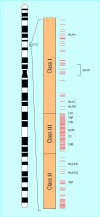Science, medicine, and the future: susceptibility to infection
- PMID: 11053181
- PMCID: PMC1118849
- DOI: 10.1136/bmj.321.7268.1061
Science, medicine, and the future: susceptibility to infection
Figures


References
-
- Comstock GW. Tuberculosis in twins: a re-analysis of the prophit survey. Am Rev Respir Dis. 1978;117:621–624. - PubMed
-
- Fine PE. Immunogenetics of susceptibility to leprosy, tuberculosis, and leishmaniasis. An epidemiological perspective. Int J Lepr Other Mycobact Dis. 1981;49:437–454. - PubMed
-
- Jepson AP, Banya WA, Sisay-Joof F, Hassan-King M, Bennett S, Whittle HC. Genetic regulation of fever in Plasmodium falciparum malaria in Gambian twin children. J Infect Dis. 1995;172:316–319. - PubMed
-
- Malaty HM, Engstrand L, Pedersen NL, Graham DY. Helicobacter pylori infection: genetic and environmental influences. A study of twins. Ann Intern Med. 1994;120:982–986. - PubMed
-
- Sorensen TI, Nielsen GG, Andersen PK, Teasdale TW. Genetic and environmental influences on premature death in adult adoptees. N Engl J Med. 1988;318:727–732. - PubMed
Publication types
MeSH terms
LinkOut - more resources
Full Text Sources
